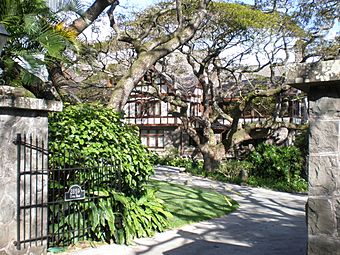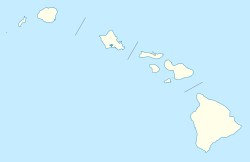Charles Montague Cooke Jr. House and Kūkaʻōʻō Heiau facts for kids
Quick facts for kids |
|
|
Charles Montague Cooke Jr. House and Kūka‘ō‘ō Heiau
|
|

Kualii, view from the main gate
|
|
| Location | 2859 Manoa Rd., Honolulu, Hawaii |
|---|---|
| Built | 1912 |
| Architect | Emory & Webb |
| Architectural style | Tudor Revival |
| NRHP reference No. | 85003402 and 00000267 |
| Added to NRHP | October 31, 1985 (original) and August 30, 2000 (increase) |
The Charles Montague Cooke Jr. House and Kūkaʻōʻō Heiau are important historical sites in Honolulu, Hawaii. The house is also known as Kualii. It was built between 1911 and 1912 for Charles Montague Cooke Jr.
Both the house and the ancient Hawaiian temple, called a heiau, are listed on the National Register of Historic Places. This means they are recognized as very important historical places. The heiau was added to the listing in 2000.
Contents
The Kualii House: A Look Back
Building a Dream Home
In 1902, a rich businessman named Charles Montague Cooke gave his son, Monty, a large piece of land. This land was on a high ridge in Mānoa Valley. It was special because it already had an ancient Hawaiian heiau on it.
Monty married Lila Lefferts that same year. In 1911, he decided to build a grand house. He hired two famous architects, Walter Emory and Marshall Webb. They designed a large stone mansion in the Tudor style.
The house was built on the hillside above the heiau. It cost $40,000, which was a lot of money back then! Monty named the house Kualii, after an old Hawaiian chief.
What the House Looks Like
The Kualii house has a strong base made of basalt lava rock. This rock was dug up right from the building site. This base supports two upper floors.
These upper floors are built with a style called half-timber and stucco. Half-timber means you can see the wooden beams on the outside walls. Stucco is a type of plaster that covers the walls.
There are two big stone chimneys at each end of the house. One chimney is for the kitchen, and the other is for the living room. The main entrance has a covered driveway called a porte-cochere. It has strong stone columns.
Kūkaʻōʻō Heiau: An Ancient Hawaiian Temple
What is a Heiau?
A heiau is an ancient Hawaiian temple or place of worship. The name of this heiau, Kūkaʻōʻō, has a special meaning. It comes from Hawaiian words that can mean 'Kū of the digging stick' or 'standing digging stick'.
One old story says a chief named Kawelo threw a digging stick from a mountain. It landed on the hill where the heiau now stands. This hill is called Puʻu Pueo, which means 'owl hill'.
The Heiau's Design and History
The Kūkaʻōʻō Heiau is shaped like a square. It measures about 12 meters (about 39 feet) across. It stands about 6 meters (about 20 feet) above the flat, rocky area around it.
An expert from the Bishop Museum, Kenneth Emory, thought the heiau was about 1,000 years old. In the past, the gardens around the heiau helped feed the people of the ahupuaʻa of Waikiki. An ahupuaʻa was a traditional land division in Hawaii.
Bringing the Heiau Back to Life
By 1992, the old heiau walls were very overgrown. Samuel Alexander Cooke, a grandson of Charles Montague Cooke Jr., and his wife Mary bought the land. They wanted to restore the heiau.
They hired Nathan Napoka, a preservation expert, to rebuild the walls. A stonemason named Billy Fields used old drawings from the 1930s. He only used rocks found right there on the site.
In 1996, the Mānoa Heritage Center was created. This center now takes care of the site. They also offer educational tours so people can learn about this important place.
Gallery






